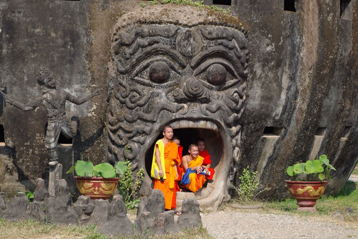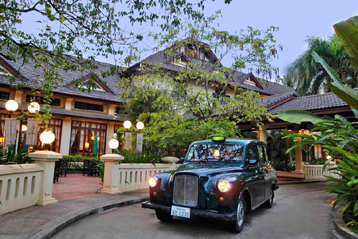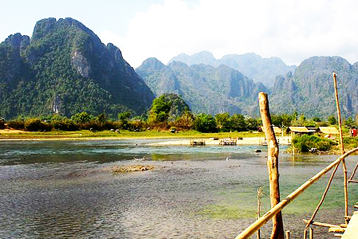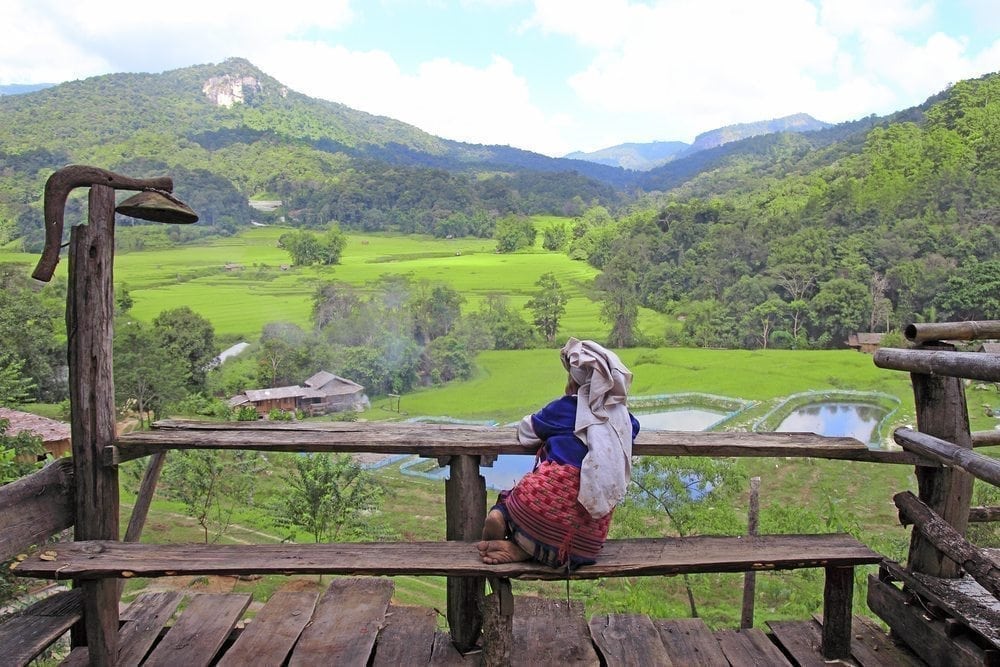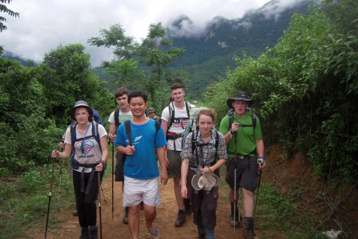Arts
The focus of most traditional art in Lao culture has been religious, specifically Buddhist. Yet, unlike the visual arts of Thailand, Myanmar and Cambodia, lever encompassed a broad range of styles and periods, mainly become has a much more modest history in terms of power and because existed as a political entity for a short period. Furthermore, since Laos was intermittently dominated by its neighbors, much of the art that was either destroyed or, as in the case of the Emerald Buddha carted off by conquering armies.
Lao’s relatively small and poor population, combined with a turbulent recent history, also goes some way toward explaining the absence of strong tradition of contemporary art. This is slowly changing, and in Vientiane and Luang Prabang modern art in a variety of media is finding its way into galleries and stores.
Weaving is the one art form that is found almost everywhere has distinct styles that vary by place and tribal group. It s also the single most accessible art the traveler can buy, often from the artist herself – weavers are almost always women.
ArchitectureAs with all other artistic endeavor, for centuries the best architects in the land have focused their attention on Buddhist temples . The results are most impressive in Luang Prabang.
However, it’s not only in temples that Laos has its own peculiar architectural traditions. The that (stupa) found in Laos are different to those found anywhere else in the Buddhist world. Stupas are essentially monuments built on top of a reliquary which itself was built to hold a relic of the Buddha – commonly a hair or fragment of bone. Across Asia they come in varying shapes and sizes, ranging from the multi-level tapered pagodas found in Vietnam to the buxom brick monoliths of Sri Lanka. Laos has its own unique style combining hard edges and comely curves. The most famous of all Lao stupa is the golden Pha That Luang in Vientiane, the national symbol.
Traditional housing in Laos, whether in the river valleys or in the mountains, consists of simple wooden or bamboo-thatch structures with lea grass roofing. Among lowland Lao, houses are raised on stilts to avoid flooding during the monsoons and allow room to store rice underneath, w the highlanders typically build directly on the ground. The most attractive lowland Lao houses often have a starburst pattern in the architraves, the these are increasingly difficult to find.
Colonial architecture in urban Laos combined the classic French provincial style – thick-walled buildings with shuttered windows and pitched tile roofs with balconies and ventilation to promote air circulation in the stifling Southeast Asian climate. Although many of these structures were torn down or allowed to decay following independence from France, today they are much in demand, especially by foreigners. Luang Prabang and Vienn both boast several lovingly restored buildings from this era. By contra the Mekong River towns of Tha Khaek, Savannakhet and Pakse Frenc buildings are decaying at a disturbing rate.
Buildings erected in post-Revolution Laos followed the socialist realism school that was enforced in the Soviet Union, Vietnam and China. Straight lines, sharp angles and an almost total lack of ornamentation were the norm. More recently, a trend towards integrating classic Lao architectural motifs with modern functions has taken hold. Prime examples of this inc Vientiane’s National Assembly and the Luang Prabang airport, both of which were designed by Havana- and Moscow-trained architect Hongkad Souvannavong. Other design characteristics, such as those represented by the Siam Commercial Bank on Th Lan Xang in Vientiane, seek to gracefully reincorporate French colonial features ignored for the last half-century.
However, it’s not only in temples that Laos has its own peculiar architectural traditions. The that (stupa) found in Laos are different to those found anywhere else in the Buddhist world. Stupas are essentially monuments built on top of a reliquary which itself was built to hold a relic of the Buddha – commonly a hair or fragment of bone. Across Asia they come in varying shapes and sizes, ranging from the multi-level tapered pagodas found in Vietnam to the buxom brick monoliths of Sri Lanka. Laos has its own unique style combining hard edges and comely curves. The most famous of all Lao stupa is the golden Pha That Luang in Vientiane, the national symbol.
Traditional housing in Laos, whether in the river valleys or in the mountains, consists of simple wooden or bamboo-thatch structures with lea grass roofing. Among lowland Lao, houses are raised on stilts to avoid flooding during the monsoons and allow room to store rice underneath, w the highlanders typically build directly on the ground. The most attractive lowland Lao houses often have a starburst pattern in the architraves, the these are increasingly difficult to find.
Colonial architecture in urban Laos combined the classic French provincial style – thick-walled buildings with shuttered windows and pitched tile roofs with balconies and ventilation to promote air circulation in the stifling Southeast Asian climate. Although many of these structures were torn down or allowed to decay following independence from France, today they are much in demand, especially by foreigners. Luang Prabang and Vienn both boast several lovingly restored buildings from this era. By contra the Mekong River towns of Tha Khaek, Savannakhet and Pakse Frenc buildings are decaying at a disturbing rate.
Buildings erected in post-Revolution Laos followed the socialist realism school that was enforced in the Soviet Union, Vietnam and China. Straight lines, sharp angles and an almost total lack of ornamentation were the norm. More recently, a trend towards integrating classic Lao architectural motifs with modern functions has taken hold. Prime examples of this inc Vientiane’s National Assembly and the Luang Prabang airport, both of which were designed by Havana- and Moscow-trained architect Hongkad Souvannavong. Other design characteristics, such as those represented by the Siam Commercial Bank on Th Lan Xang in Vientiane, seek to gracefully reincorporate French colonial features ignored for the last half-century.
Sculpture
Of all the traditional Lao arts, perhaps most impressive is the Buddhist sculpture of the period from the 16th to 18th centuries, the heyday of the kingdom of Lan Xang. Sculptural media usually included bronze, stone or wood and the subject was invariably the Lord Buddha or figures associated with the Jataka (stla-dok, stories of the Buddha’s past lives). Like other Buddhist sculptors. The Lao artisans emphasized the features thought to be peculiar to the historical curled hair.
Two types of standing Buddha image are distinctive to Laos. The first is “the calling for rain” posture, which depicts the Buddha standing with hands held rigidly at his side, fingers pointing towards the ground. This posture is rarely seen in other Southeast Asian Buddhist art traditions. The slightly rounded “boneless” look of the image recalls Thailand’s Sukhothai style, and the way the lower robe is sculpted over the hips looks vaguely Khmer. But the flat, slab like earlobes, arched eyebrows and aquiline nose are uniquely Lao. The bottom of the figure’s robe curls upward on both sides in a perfectly symmetrical fashion that is also unique and innovative.
The other original Lao image type is the “Contemplating the Bodhi Tree” Buddha. The Bodhi tree “ Tree of Enlightenment”, refer to the large banyan tree that the historical Buddha purported was sitting beneath when he attained enlightenment in Bodhgaya, India, in the 6th century BC. In this image the Buddha is standing in much the same way as in the “ Calling for the rain” pose, except that his hands are crossed at the wrists in the front of his body. The finest examples of the Lao sculpture are found in Vientiane’s Haw Pha kaeo and Wat Si Saket and in Luang Prabang’s Royal Palace
Two types of standing Buddha image are distinctive to Laos. The first is “the calling for rain” posture, which depicts the Buddha standing with hands held rigidly at his side, fingers pointing towards the ground. This posture is rarely seen in other Southeast Asian Buddhist art traditions. The slightly rounded “boneless” look of the image recalls Thailand’s Sukhothai style, and the way the lower robe is sculpted over the hips looks vaguely Khmer. But the flat, slab like earlobes, arched eyebrows and aquiline nose are uniquely Lao. The bottom of the figure’s robe curls upward on both sides in a perfectly symmetrical fashion that is also unique and innovative.
The other original Lao image type is the “Contemplating the Bodhi Tree” Buddha. The Bodhi tree “ Tree of Enlightenment”, refer to the large banyan tree that the historical Buddha purported was sitting beneath when he attained enlightenment in Bodhgaya, India, in the 6th century BC. In this image the Buddha is standing in much the same way as in the “ Calling for the rain” pose, except that his hands are crossed at the wrists in the front of his body. The finest examples of the Lao sculpture are found in Vientiane’s Haw Pha kaeo and Wat Si Saket and in Luang Prabang’s Royal Palace
Handicrafts
Mats and baskets woven of various kinds of straw, rattan and reed common and are becoming a small but important export. You’ll still minority groups actually wearing some of these baskets, affirming I until recently most Lao handicrafts were useful as well as ornamental. In villages it’s possible to buy direct from the weaver, though you might need to commission your basket in advance and allow at least a day for the jop to be finished. Or you could weave it yourself, under instruction from experts for a small fee. Among the best baskets and mats are those w by the Htin (Lao Thoeng).
Among the Hmong and Mien hill tribes, silversmithing plays an important in “portable wealth” and inheritances. In years past the main source of silver was French coins, which were either melted down or fitted straight into the jewellery of choice. In northern villages it’s not unusual to see newer coins worn in elaborate head dress.
The lowland Lao also have a long tradition of silversmithing and goldsmithing. While these arts have been in decline for quite a while now. You can still see plenty of jewellers working over flames in markets around the country. If you’re after something special head to Luang Prabang, where Thithpeng Maniphone has gone from Grafting silverware for Luang Prabang royalty to filling commissions for the Thai royal family.
Paper handcrafted from săa (the bark of a mulberry tree) is common in northwestern Laos, and is available in Vientiane and Luang Prabang .Environmentally friendly săa is a renewable paper resource that needs little processing compared with wood pulp.
Among the Hmong and Mien hill tribes, silversmithing plays an important in “portable wealth” and inheritances. In years past the main source of silver was French coins, which were either melted down or fitted straight into the jewellery of choice. In northern villages it’s not unusual to see newer coins worn in elaborate head dress.
The lowland Lao also have a long tradition of silversmithing and goldsmithing. While these arts have been in decline for quite a while now. You can still see plenty of jewellers working over flames in markets around the country. If you’re after something special head to Luang Prabang, where Thithpeng Maniphone has gone from Grafting silverware for Luang Prabang royalty to filling commissions for the Thai royal family.
Paper handcrafted from săa (the bark of a mulberry tree) is common in northwestern Laos, and is available in Vientiane and Luang Prabang .Environmentally friendly săa is a renewable paper resource that needs little processing compared with wood pulp.
Music and Dance
Lao classical music was originally developed as court music for royal ceremonies and classical dance-drama during the 19th-century reign of Vientiane’s Chao Anou, who had been educated in the Siamese court in Bangkok. The standard ensemble for this genre is the sep nyai and consist of khăng wóng ( a set of tuned gongs ) the ranyâat (a xylophone-like instrument), the khui(bamboo flute ) and the pii (a double-reed wind instrument similar to the oboe).
The practice of classical Lao music and drama has been in decline for some time- 40 years of intermittent war and revolution has simply made this kind entertainment a low priority among most Lao. Generally, the only time you will hear this type of music is during the occasional public performance of the Pha lakPha Lam, a dance -drama based on the Hindu Ramayana epic.
Not so with Lao folk and pop, which have always stayed close to the people The principal instrument in folk, and to a lesser extent in pop, is the Kháen (common French spelling: khene ), a wind instrument that is devised of a double row of bamboo-like reeds fitted into a hardwood sound box and made air – tight with beeswax. The rows can be as few as four or as many as eight courses (for a total of 16 pipes), and the instrument can vary in length l80 cm to about 2m. An adept player can produce a churning, calliope – like dance music.
When the Kháen is playing you’ll often see people dancing the lám wóng ( circle performance) , easily the most popular folk dance in Laos. Put simply, in the lám wóng couple, and one danced by the whole crowd. Watch for a few minutes and you’ll soon get the hang of it.
The practice of classical Lao music and drama has been in decline for some time- 40 years of intermittent war and revolution has simply made this kind entertainment a low priority among most Lao. Generally, the only time you will hear this type of music is during the occasional public performance of the Pha lakPha Lam, a dance -drama based on the Hindu Ramayana epic.
Not so with Lao folk and pop, which have always stayed close to the people The principal instrument in folk, and to a lesser extent in pop, is the Kháen (common French spelling: khene ), a wind instrument that is devised of a double row of bamboo-like reeds fitted into a hardwood sound box and made air – tight with beeswax. The rows can be as few as four or as many as eight courses (for a total of 16 pipes), and the instrument can vary in length l80 cm to about 2m. An adept player can produce a churning, calliope – like dance music.
When the Kháen is playing you’ll often see people dancing the lám wóng ( circle performance) , easily the most popular folk dance in Laos. Put simply, in the lám wóng couple, and one danced by the whole crowd. Watch for a few minutes and you’ll soon get the hang of it.
Măw Lám
The Lao folk idiom also has its own musical theatre, based on the măw lám tradition. Măw Lám is difficult to translate but roughly means “master of verse”. Led by one or more vocalists, performances always feature a witty, topical combination of talking and singing that ranges across themes as diverse as politics and sex. Very colloquial, even bawdy, language is employed. This is one art form that has always bypassed government censors and it continue to provide an important outlet for grass-roots expression.
Diverse other instruments, including electric guitar, electric bass and drums may supplement the basic Kháen / vocalist ensemble. Versions that appear on Lao national television are usually much watered down to suit ‘national development’
There are several different types of măw lám, depending on the number of the singers and the region the style hails from. Măw lámkhu (couple măw lám ), for example, features a man and woman who engage in flirtation and verbal repartee. Măw lám jot (duelling măw lám ) has two performer of the same gender who ‘duel’ by answering questions or finishing an incomplete story issued as a challenge – not unlike free-style rap.
Northern Lao Kháen – based folk music is usually referred to as kháp rather than lám. Authentic live măw lám can be heard at temple fairs and on Lao radio. CD can be purchase in larger towns and cities.
Diverse other instruments, including electric guitar, electric bass and drums may supplement the basic Kháen / vocalist ensemble. Versions that appear on Lao national television are usually much watered down to suit ‘national development’
There are several different types of măw lám, depending on the number of the singers and the region the style hails from. Măw lámkhu (couple măw lám ), for example, features a man and woman who engage in flirtation and verbal repartee. Măw lám jot (duelling măw lám ) has two performer of the same gender who ‘duel’ by answering questions or finishing an incomplete story issued as a challenge – not unlike free-style rap.
Northern Lao Kháen – based folk music is usually referred to as kháp rather than lám. Authentic live măw lám can be heard at temple fairs and on Lao radio. CD can be purchase in larger towns and cities.
Literature
Of all the classical Lao literature, Pha Lak Pha Lam, the Lao version of the Indian, epic the Ramayana, is the most pervasive and influential in the culture. The Indian source first came to Laos with the Hindu Khmer as stone reliefs at Wat Phu Champasak other Angkor – period temples. Oral and written versions may also have been available; eventually, though the Lao developed their own version of the epic, which differs greatly both from the original and from Thailand’s Ramakian.
Of the 547 Jataka tales in the Pali Tipitaka (tripartite Buddhist canon each chronicling a different past life of the Buddha – most appear in Laos almost word-for-word as they were first written down in Sri Lanta. A group of 50 ‘extra’ or apocryphal stories – based on Lao-Thai folk tales of the time – were added by Pali scholars in Luang Prabang between 300 and 400 years ago. Laos’s most popular Jataka is an old Pali original known as the Mahajati or Mahavessandara (Lao: Pha Wet), the story of the Buddha’s penultimate life. Interior murals in the sim of many Lao wat typically depict this Jataka as well as others.
Contemporary literature has been hampered by decades of war and communist rule. Only in 1999 was the first collection of contemporary Lao fiction. Ounthine Bounyavong’s Mother’s Beloved: Stories from Laos, published in a bilingual Lao and English edition.
Of the 547 Jataka tales in the Pali Tipitaka (tripartite Buddhist canon each chronicling a different past life of the Buddha – most appear in Laos almost word-for-word as they were first written down in Sri Lanta. A group of 50 ‘extra’ or apocryphal stories – based on Lao-Thai folk tales of the time – were added by Pali scholars in Luang Prabang between 300 and 400 years ago. Laos’s most popular Jataka is an old Pali original known as the Mahajati or Mahavessandara (Lao: Pha Wet), the story of the Buddha’s penultimate life. Interior murals in the sim of many Lao wat typically depict this Jataka as well as others.
Contemporary literature has been hampered by decades of war and communist rule. Only in 1999 was the first collection of contemporary Lao fiction. Ounthine Bounyavong’s Mother’s Beloved: Stories from Laos, published in a bilingual Lao and English edition.
More guide...
Responsible Travel
Being a responsible eco tour operator is at the heart of what ACTIVETRAVEL ASIA is all about. From the start, we have been committed to offering low-impact tours that benefit traveler and host alike. We work with local communities, businesses and individuals to develop sustainable tourism opportunities that help local economies while minimizing negative environmental and cultural impacts.
Asia Travel News


